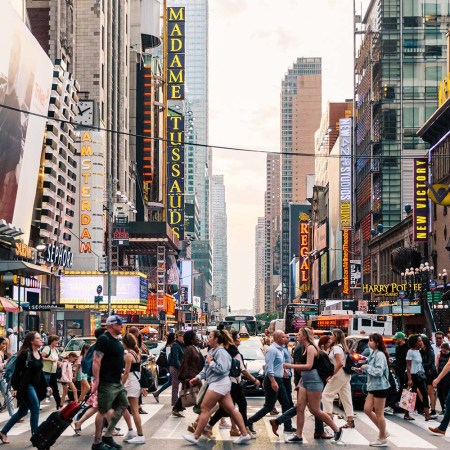The art historian Vincent Scully (of no relation to the late broadcaster) has perhaps the most accurate quotation on the difference between New York City’s original Penn Station, and the one we all know and hate today: “Through Pennsylvania Station one entered the city like a god. Perhaps it was really too much. One scuttles in now like a rat.”
The old Pennsylvania Station was every bit as regal as Grand Central, a Beaux-Arts masterpiece, which — until it was demolished in 1963 — featured an opulent concourse with 148-foot glass ceilings. The space was based on Ancient Rome’s Baths of Caracalla, and it was a place to linger. A 1955 menu shows a bevy of seafood specialities for two dollars or less, including creamy lobster pan stews. If you told someone in 2022 that you planned to eat a bowl of fish in the fluorescent corridors under 7th Avenue, they’d pray for you on the spot.
Commuters have felt a bit less like rodents since Moynihan Train Hall, an expansion of Penn Station that took over New York’s old primary post office, opened at the beginning of 2021. The $1.6 billion project provides access to most Amtrak and Long Island Rail Road tracks and has eased congestion as ridership has climbed closer to pre-pandemic figures. There is also a modern take on a soaring glass ceiling.
But the Penn Station below Madison Square Garden, the one that services 650,000 riders each day across its many platforms, is in desperate need of a makeover. It’s been a laughingstock for so long that Governor Kathy Hochul and New York State officials are supporting a plan to fix it that might not actually be in the best interest of the city. The so-called Penn Station Plan, which The New York Times today dubbed “one of the largest real estate development projects in American history,” would involve a full-scale renovation of the station…and also the construction of 10 towers in the area immediately around it.
It would’ve been difficult to oppose this sort of plan a decade ago. That’s when the city plowed forward with Hudson Yards, a 28-acre development that dramatically changed the New York City skyline, with millions of square feet in new office space, plus luxury shops, bougie food markets and high-rise condos. The investment was off to a good start — attracting Fortune 500 companies and multi-millionaire renters — before it was completely upended by the pandemic. Now, while Hudson Yards has emerged as a popular tourist destination, it’s having trouble filling all its space, and particularly the office space. Nearly 40% of it is currently unoccupied, and Related Companies, the real estate firm that developed Hudson Yards, has temporarily halted construction on the other half of its project, called Western Rail Yards.
After all, why in the world would it want to build more offices? About a third of New Yorkers are permanently working from home. Those in hybrid workflows will be in their offices “half as often” going forward, according to research conducted by Stanford University. Only San Francisco will post a larger percentage in “reduction of days on business premises.” Anecdotal accounts corroborate the research — a majority of laptop-job New Yorkers would rather work from their “shoebox apartments” than commute to a skyscraper each day.
So why is New York City planning to add 10 more massive towers in Midtown Manhattan? The linchpin is Penn Station. When this plan goes through, and recent reports suggest that it will, Penn Station’s renovation will be the first project to come to fruition. By 2027, the maligned epicenter will have been rebuilt with higher ceilings, more windows and more entrances. It will be a completely different commuter experience, as rendered here and here. Considering the frequency with which Penn Station is compared to the pits of hell, literally any improvement would win favor with locals. But these sorts of changes, assuming construction isn’t delayed, would be legacy-defining for Hochul and her acolytes.
Plus: under this plan, Vornado Realty Trust (which will develop the majority of the new towers), would pay for the renovation of Penn Station. (They’ll get decades of property tax breaks on their buildings in return, which should be completed in the 2040s.) It’s somewhat unfathomable to imagine what day-to-day work will look like in New York City 25 years from now — just three years ago we wouldn’t have recognized the terms “Zoom” or “social distancing.” Can we possibly be sure that that big-ticket tenants will be able to fill another 18 million square feet of office space, which, by the way, would create a skyscraper corridor of oversized offices from the Hudson River eastward to the Empire State Building? Gen Z will be middle-aged and with kids by the end of this development. What percentage of the workforce will even remember a time when commuting to an office five days a week was mandatory?
Some officials seem convinced that in order for big cities to make a comeback, they need to reinvest in their downtowns. That’s certainly true — but does that reinvestment have to arrive in the form of more office space? Why is the fate of Penn Station inextricably tied to the building of some of North America’s one-day highest towers? Urbanism experts have forecast that cities can thrive in a post-pandemic future, without having to create more office space; Richard Floria astutely pointed out to Insider in 2021: “Even as offices decline, the community or the neighborhood or the city itself will take on more of the functions of an office. People will gravitate to places where they can meet and interact with others outside of the home and outside of the office.”
New Yorkers will celebrate a revamped Penn Station, but the cost could be an unholy influx of cubicles that never see any use. It’s a shame, too, considering that the city’s housing crisis has reached its apex this summer, with a dearth of affordable units. Cities across America are starting to reassess the use of downtown high-rises and relitigate their zoning laws, in order to potentially move their citizens into buildings that would otherwise go unused. Such conversions are time-consuming and expensive, but then, so is signing off on one of the most sweeping real estate projects in the country’s history.
New York has long viewed its return to normalcy in the context of how many people can be spotted walking around Midtown Manhattan again. The ghost town that the city became in the middle of the pandemic still weighs on the nerves of locals and state officials alike. But banking on a return to work seems to ignore the fact that the remote work phenomenon is here to stay — and that the city has been marching on, just perhaps not in the way that everyone had gotten accustomed to.
It’s a welcome reminder, and one, as Penn Station enters yet another phase in a few years, that it’s a wonder we ever forget. New York likes to change, and it doesn’t wait around for anyone, god, rat or otherwise, to catch up.
Thanks for reading InsideHook. Sign up for our daily newsletter and be in the know.



















